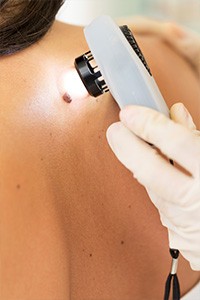 Preventative Skin Cancer & Melanoma Screenings In West Chester, PA
Preventative Skin Cancer & Melanoma Screenings In West Chester, PA
What is skin cancer? The answer comes in many forms, however at its core skin cancer is the uncontrolled growth of abnormal skin cells. This can occur when unrepaired damage to skin cells triggers mutations or defects in your skin's DNA - leading to skin cells that rapidly form malignant tumors or growths. At Hurley Dermatology, we want you to be aware of the warning signs of potentially deadly skin cancer and how you can prevent it.
Common Forms of Skin Cancer
There are three common forms of skin cancer:
- Basal Cell Carcinoma
- Squamous Cell Carcinoma
- Malignant Melanoma
Doctors link these forms of cancer to overexposure to ultraviolet radiation from the sun and tanning beds. Since each type of skin cancer has a different look, effect, and treatment, it is important to alert your physician if you notice unusual changes in the size, shape or color of spots or moles. When caught early, many forms of skin cancer can be successfully treated.
Basal Cell Carcinoma
Basal Cell Carcinoma is the most prevalent form of skin cancer. It often appears as an irregularly shaped blemish or blister that crusts over or bleeds without healing. While this form of cancer is rarely life threatening, failure to treat it in a timely manner can cause serious damage to nerves, tissue and bones.
Squamous Cell Carcinoma
Squamous Cells often originate on the face and other sun-exposed areas. They can appear as a reddish spot with thick white scales. This type of skin cancer tends to grow relatively quickly, and is sometimes painful. If not treated, it can spread to the internal organs and become a life threatening condition.
Malignant Melanoma
Melanoma is the deadliest form of skin cancer. This type of cancer generally begins within moles. While it occurs less frequently than the other forms of skin cancer, it is more dangerous because, if not treated quickly, it can spread throughout the entire body. Dr. Hurley recommends that you regularly check your moles, and schedule yearly skin mapping appointments. When looking for potentially dangerous spots, remember your ABCDEs:
- Asymmetry - if you draw a line through the mole and the two sides to not match.
- Borders - the borders of a melanoma in early stages tend to be uneven.
- Color - having a variety of colors and shades can be an indicator of a melanoma.
- Diameter - melanomas are generally larger in diameter than regular moles, however they may be smaller when first detected. Moles should be no larger than the size of a pencil eraser.
- Evolving - any change in size, shape, color or elevation is a warning sign, as well as new symptoms such as bleeding, itching or scabbing.
What Do I Do If I Have Skin Cancer?
In situations where the cancer is relatively small, your doctor will surgically remove the tumor and then reconstruct the area. In certain circumstances, a procedure known as Mohs surgery (in which the cancer is taken off in layers) is used in eradicating cancerous cells. The important thing is to contact your doctor immediately for a consultation if you feel that you are showing symptoms of any of these conditions. After surgery, it is important to carefully check your skin regularly for recurrences, and you should visit your doctor regularly for routine exams.
Schedule Your Skin Cancer Screening Today
We are strong believers that early prevention and careful monitoring is key when it comes to avoiding potentially deadly skin cancers. In addition to protecting your skin in the sun, you should regularly check your skin for irregular bumps, lesions or moles. We also encourage you to call us at 610-918-2500 to schedule your skin cancer screening with Hurley Dermatology. During this appointment we will make sure any concerns of yours are addressed and fully assess the health of your skin.
